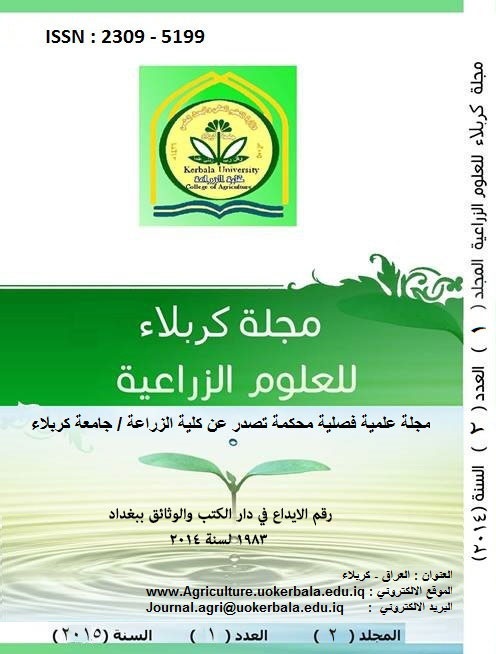control on fungal rot tomato and cucumber fruits using the best concentration of aloe vera extract
DOI:
https://doi.org/10.59658/jkas.v2i1.465Keywords:
Aloe vera L. Fusarium pseudoanthophilum , aphanidermatum PythiumAbstract
This study included isolation and diagnose the fungi causing damage and rot of cucumber and tomato fruits after harvest .And determine the best concentration of of aloe vera extract that inhibits fungal growth and sporulation .The ability of this extract in protecting tomato and cucumbers fruits under cold storage conditions .
Alternaria alternata , Drechslera australiensis , Fusarium pseudoanthophilum and Pythium aphanidermatum were isolation from tomato and cucumbers fruits showing symptoms . The fungus F. pseudoanthophilum was recorded for the first time in Iraq as causer of tomato and cucumber fruits rot . Aspergillus niger , A. oryzae , A. terreus and Penicillium chrysogenum fungi were isolated from fruits surfaces by dilution method .
Results revealed that all concentrations of Aloe vera extract inhibited tested fungi and the concentrate of 20% was the most effective where the inhibition after 72 hours were 82.53. The results extract was capable to prevent the growth of P. aphanidermatum completely .The extract inhibited the germination of A. alternata 4 and Penicillium chrsogenum spores by 70.62 and 67.61% respectively .The inhibition percentage of isolates spores 1, 2 and 3 of A. alternata were 54.7 , 64.46 and 60. 57%, respectively, and for D.australiensis spores were 49.04% .
Results of applied experiments revealed the ability to use Aloe vera extraction in protecting tomatoes and cucumber fruits from infection with rot after harvest under cold condition . The average growth of A.alternata , D.australiensis F.pseudoanthophilum and P.aphanidermatum after after 20 days Aloe vera extracted treatment gave 0.09,0.07 0.12 and 0.16 cm respectively compared with the control which gave 0.12 , 0.12 ,0.17 and 0.22 cm respectively . After 25 days the growth was 0.17 , 0.15 , 0.25 and 0.35 cm respectively compared to the control treatment which gave 0.20 , 0.15 , 0.31 and 0.49 cm, respectively .
Downloads
Published
How to Cite
Issue
Section
License
Copyright (c) 2015 Copyright (c) 2024 is the Author's article. Published by the Journal of Kerbala for Agricultural Sciences under a CC BY 4.0 license

This work is licensed under a Creative Commons Attribution 4.0 International License.
Licensing Terms
All articles are published under a Creative Commons License and will be directed to the Creative Commons Attribution 4.0 International License (CC BY 4.0) That permits use, distribution, and reproduction in any medium, provided the original work is properly cited. This license also allows the work to be used for commercial purposes.
Use by both non-commercial and commercial users
This content is licensed under a Creative Commons Attribution 4.0 International (CC BY 4.0) license, permitting use by both non-commercial and commercial users. Individual users may access, download, copy, display, and redistribute the articles to colleagues, as well as adapt, translate, and text- and data-mine the content, subject to the following conditions:
- The author's moral rights, including the right of attribution and the right to protect their work from derogatory treatment, are respected.
- Where content in the article is identified as belonging to a third party, users must ensure that any reuse complies with the copyright policies of the owner of that content.
- If the article content is reused for research or educational purposes, users should maintain a link to the appropriate bibliographic citation, including the DOI and a link to the published version on the journal's website.

